What is the Difference Between AC and DC Current
What is the Difference Between AC and DC Current? (Explained)
Electricity is one of the most important inventions in human history. Our homes, industries, offices, and even modern gadgets are powered by electricity. But when we talk about electrical current, two main types come into discussion – AC (Alternating Current) and DC (Direct Current). Both play a vital role in our daily lives, yet they are different in nature, application, and advantages. In this article, we will explain the difference between AC and DC current, their history, working principle, pros and cons, and practical uses.
What is AC Current?
AC (Alternating Current) is the type of electric current that changes its direction periodically. This means the flow of electrons keeps reversing at a specific frequency (measured in Hertz). For example, in most countries, AC power supply runs at 50 Hz or 60 Hz, which means the current changes direction 50 or 60 times per second.
AC is the type of current that comes to our homes through power stations and transmission lines. When you plug in your fan, fridge, or television, they all work on AC supply.
Key Features of AC Current
- Changes direction periodically
- Can be transmitted over long distances efficiently
- Produced by alternators in power plants
- Frequency depends on the country (50Hz or 60Hz)
What is DC Current?
DC (Direct Current) is the type of electric current that flows in one direction only. Unlike AC, the flow of electrons in DC does not change. It is steady, stable, and constant.
Common sources of DC power are batteries, solar panels, and fuel cells. Small electronics like smartphones, laptops, and LED lights mostly work on DC current. Even though your home gets AC power, many appliances internally convert AC to DC to function properly.
Key Features of DC Current
- Flows in one constant direction
- Stable and smooth power supply
- Produced by batteries, solar panels, and rectifiers
- Used in low-voltage applications and electronics
History of AC and DC Current
The “War of Currents” in the late 19th century played a major role in popularizing AC.
- Thomas Edison was a strong supporter of DC. He believed DC was safer and suitable for electrical supply.
- Nikola Tesla and George Westinghouse promoted AC because it could be transmitted long distances without much power loss.
In the end, AC became the standard for power distribution, while DC found its place in electronics, batteries, and modern renewable energy systems.
Working Principle of AC vs DC
- AC Current: Generated by alternators, where the magnetic field rotates inside coils of wire, producing alternating voltage.
- DC Current: Generated by sources like batteries, where chemical reactions create a steady flow of electrons in one direction.
Difference Between AC and DC Current (Comparison Table)
| Feature | AC Current | DC Current |
|---|---|---|
| Full Form | Alternating Current | Direct Current |
| Flow of Electrons | Changes direction periodically | Flows in one direction only |
| Source | Power plants, alternators | Batteries, solar panels, rectifiers |
| Transmission | Can travel long distances | Suitable for short distances |
| Voltage Conversion | Easily transformed with transformers | Difficult to change voltage |
| Cost | Cheaper for distribution | More expensive for long distance |
| Usage | Homes, industries, large machines | Electronics, mobile devices, EVs |
| Frequency | 50Hz or 60Hz | Zero frequency (steady flow) |
Advantages of AC Current
- Easy to transmit over long distances
- Voltage can be increased or decreased using transformers
- Suitable for powering homes and industries
- Lower energy loss in transmission
Advantages of DC Current
- Provides stable power output
- Essential for electronics and digital devices
- Can be stored in batteries
- Plays a key role in renewable energy (solar, wind, EVs)
Applications of AC Current
- Power supply to homes, offices, industries
- Operating heavy machinery, motors, and pumps
- Used in appliances like refrigerators, air conditioners, washing machines
Applications of DC Current
- Powering mobile phones, laptops, LED TVs
- Renewable energy systems (solar panels generate DC)
- Electric vehicles and battery storage
- Low-voltage applications like sensors, circuits
Which is Better – AC or DC?
It depends on the application. AC is better for power transmission over long distances, while DC is better for electronics and storage. Both are equally important, and modern technology often uses a combination of both. For example, your home gets AC supply, but your phone charger converts it into DC to charge the battery.
Future of AC and DC
With the rise of renewable energy and electric vehicles, DC is becoming more important than ever. Solar panels and batteries generate DC, while electric vehicles run on DC-powered batteries. On the other hand, AC will continue to dominate the power distribution system worldwide.
Future power grids may use AC for transmission and DC for storage and consumption – a hybrid system for maximum efficiency.
Conclusion
Both AC (Alternating Current) and DC (Direct Current) are fundamental to modern electrical systems. AC powers our homes and industries, while DC powers our gadgets, renewable energy, and electric vehicles. Instead of competing, AC and DC complement each other in different fields.
So, whenever someone asks – “What is the difference between AC and DC current?” – you can confidently say:
- AC changes direction and is used for long-distance power supply.
- DC flows in one direction and is used for electronics and storage.


